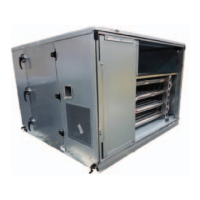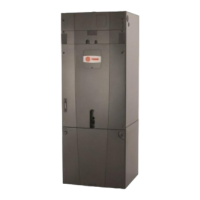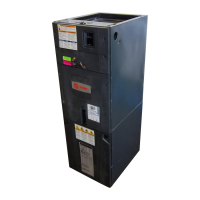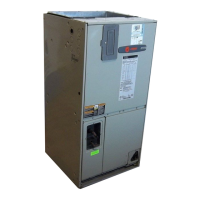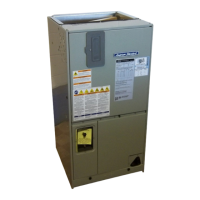16 CLCH-SVX014B-EN
Piping
Gas Piping
Note: Installation must conform with the American
National Standard Z223.1 (NFPA 54), the National
Fuel Gas Code, latest edition, in the absence of local
codes.
• Gas piping should always be done in accordance with
local codes.
• Tighten all joints securely.
• Pipe unions should be a “ground joint” type to prevent
leakage.
• Provide adequate support for field-installed piping to
avoid placing stress on the gas train and controls.
• Run takeoff lines from the side or top of the main gas
line to prevent moisture from being drawn into the gas
train of the unit.
• Provide a drip leg in the field-installed piping, installing
it near the unit.
Proper Gas Pressure
• To assure sufficient gas pressure at the unit, use
appropriately sized gas pipe for unit capacity. Refer to
the National Fuel Gas Code for pipe sizing information.
• Select an appropriately sized gas pressure regulator to
assure the required gas supply pressure is maintained
at the unit.
• For unit to operate unit properly, the inlet gas pressure
must be maintained at 7 inches wc. Required gas
pressure to the gas train is 5 to 13 inches wc
• Gas pressure and volume must be maintained and
stable at high fire.
• If the gas pressure regulator serves more than one
heating unit, it must be sized appropriately to ensure
that the inlet gas pressure at each unit is 5 to 13 inches
wc while all burners are firing.
• Check the gas supply pressure before making the final
connection to the unit. If the gas pressure is too high,
damage to the gas valve could occur.
Heat Exchanger Condensate
Piping
Condensate usually does not form in the heat exchanger
during normal heating operation. However, if the unit
operates for extended periods of time at very low fire, or
if the air handler serves as a cooling unit also, condensate
can form in the heat exchanger and should be removed.
All units are equipped with a condensate drain. The
condensate drain is on the same side as the gas train.
If a p-trap and drain is to be connected to the condensate
drain line, consult local plumbing codes for disposal of the
condensate may be a slightly acidic solution.
WARNING
Hazard of Explosion and Deadly Gases!
Failure to follow all proper safe refrigerant handling
practices could result in death or serious injury. Never
solder, braze or weld on refrigerant lines or any unit
components that are above atmospheric pressure or
where refrigerant may be present. Always remove
refrigerant by following the guidelines established by
the EPA Federal Clean Air Act or other state or local
codes as appropriate. After refrigerant removal, use dry
nitrogen to bring system back to atmospheric pressure
before opening system for repairs. Mixtures of
refrigerants and air under pressure may become
combustible in the presence of an ignition source
leading to an explosion. Excessive heat from soldering,
brazing or welding with refrigerant vapors present can
form highly toxic gases and extremely corrosive acids.
NOTICE
Excessive Gas Pressure!
Failure to maintain proper gas pressure could result in
damage to the gas train components. The gas pressure
at the inlet to the gas train must not exceed 13 in. wc.
A properly sized gas regulator that provides a
maximum of 13 in wc. of gas pressure, must be
supplied in the gas inlet line to unit.

